Accounting Principles, Financial Analysis, and UK Regulatory Framework
VerifiedAdded on 2021/06/22
|17
|3289
|256
Homework Assignment
AI Summary
This accounting assignment solution covers several key areas within financial accounting. It begins by defining the purposes, aims, and regulations of financial and management accounting, as well as identifying different users of accounting information and the types of businesses. The solution then prepares books of original entry, a profit and loss account, and a balance sheet. It includes the construction of final accounts, adjustments for bookkeeping, and the preparation of cash flow statements. Furthermore, the assignment calculates various financial ratios, including profitability, liquidity, and asset analysis ratios, with a focus on the interpretation of these ratios. Finally, it explores the UK regulatory framework for accounting, providing a comprehensive overview of the topic.
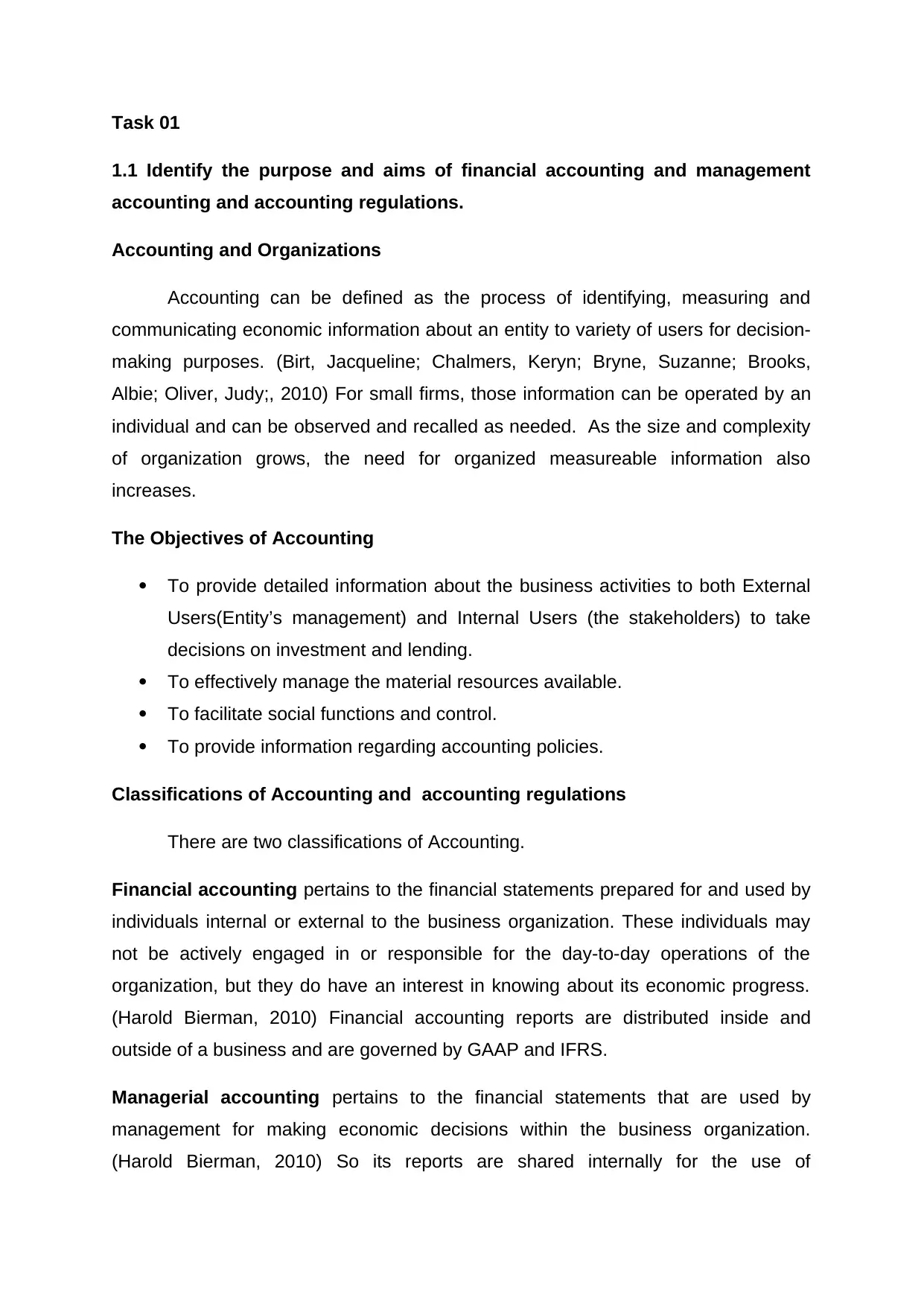
Task 01
1.1 Identify the purpose and aims of financial accounting and management
accounting and accounting regulations.
Accounting and Organizations
Accounting can be defined as the process of identifying, measuring and
communicating economic information about an entity to variety of users for decision-
making purposes. (Birt, Jacqueline; Chalmers, Keryn; Bryne, Suzanne; Brooks,
Albie; Oliver, Judy;, 2010) For small firms, those information can be operated by an
individual and can be observed and recalled as needed. As the size and complexity
of organization grows, the need for organized measureable information also
increases.
The Objectives of Accounting
To provide detailed information about the business activities to both External
Users(Entity’s management) and Internal Users (the stakeholders) to take
decisions on investment and lending.
To effectively manage the material resources available.
To facilitate social functions and control.
To provide information regarding accounting policies.
Classifications of Accounting and accounting regulations
There are two classifications of Accounting.
Financial accounting pertains to the financial statements prepared for and used by
individuals internal or external to the business organization. These individuals may
not be actively engaged in or responsible for the day-to-day operations of the
organization, but they do have an interest in knowing about its economic progress.
(Harold Bierman, 2010) Financial accounting reports are distributed inside and
outside of a business and are governed by GAAP and IFRS.
Managerial accounting pertains to the financial statements that are used by
management for making economic decisions within the business organization.
(Harold Bierman, 2010) So its reports are shared internally for the use of
1.1 Identify the purpose and aims of financial accounting and management
accounting and accounting regulations.
Accounting and Organizations
Accounting can be defined as the process of identifying, measuring and
communicating economic information about an entity to variety of users for decision-
making purposes. (Birt, Jacqueline; Chalmers, Keryn; Bryne, Suzanne; Brooks,
Albie; Oliver, Judy;, 2010) For small firms, those information can be operated by an
individual and can be observed and recalled as needed. As the size and complexity
of organization grows, the need for organized measureable information also
increases.
The Objectives of Accounting
To provide detailed information about the business activities to both External
Users(Entity’s management) and Internal Users (the stakeholders) to take
decisions on investment and lending.
To effectively manage the material resources available.
To facilitate social functions and control.
To provide information regarding accounting policies.
Classifications of Accounting and accounting regulations
There are two classifications of Accounting.
Financial accounting pertains to the financial statements prepared for and used by
individuals internal or external to the business organization. These individuals may
not be actively engaged in or responsible for the day-to-day operations of the
organization, but they do have an interest in knowing about its economic progress.
(Harold Bierman, 2010) Financial accounting reports are distributed inside and
outside of a business and are governed by GAAP and IFRS.
Managerial accounting pertains to the financial statements that are used by
management for making economic decisions within the business organization.
(Harold Bierman, 2010) So its reports are shared internally for the use of
Paraphrase This Document
Need a fresh take? Get an instant paraphrase of this document with our AI Paraphraser
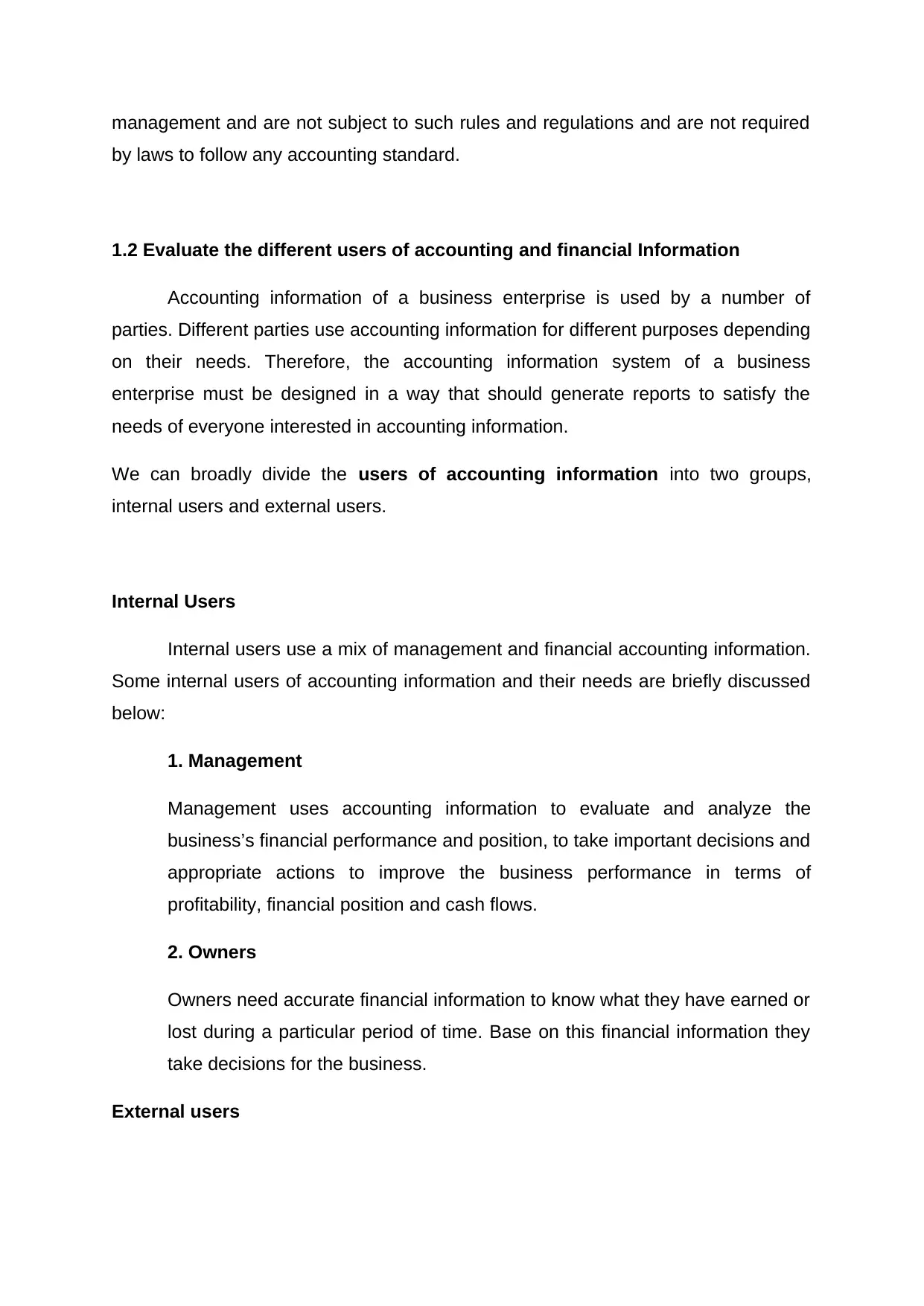
management and are not subject to such rules and regulations and are not required
by laws to follow any accounting standard.
1.2 Evaluate the different users of accounting and financial Information
Accounting information of a business enterprise is used by a number of
parties. Different parties use accounting information for different purposes depending
on their needs. Therefore, the accounting information system of a business
enterprise must be designed in a way that should generate reports to satisfy the
needs of everyone interested in accounting information.
We can broadly divide the users of accounting information into two groups,
internal users and external users.
Internal Users
Internal users use a mix of management and financial accounting information.
Some internal users of accounting information and their needs are briefly discussed
below:
1. Management
Management uses accounting information to evaluate and analyze the
business’s financial performance and position, to take important decisions and
appropriate actions to improve the business performance in terms of
profitability, financial position and cash flows.
2. Owners
Owners need accurate financial information to know what they have earned or
lost during a particular period of time. Base on this financial information they
take decisions for the business.
External users
by laws to follow any accounting standard.
1.2 Evaluate the different users of accounting and financial Information
Accounting information of a business enterprise is used by a number of
parties. Different parties use accounting information for different purposes depending
on their needs. Therefore, the accounting information system of a business
enterprise must be designed in a way that should generate reports to satisfy the
needs of everyone interested in accounting information.
We can broadly divide the users of accounting information into two groups,
internal users and external users.
Internal Users
Internal users use a mix of management and financial accounting information.
Some internal users of accounting information and their needs are briefly discussed
below:
1. Management
Management uses accounting information to evaluate and analyze the
business’s financial performance and position, to take important decisions and
appropriate actions to improve the business performance in terms of
profitability, financial position and cash flows.
2. Owners
Owners need accurate financial information to know what they have earned or
lost during a particular period of time. Base on this financial information they
take decisions for the business.
External users
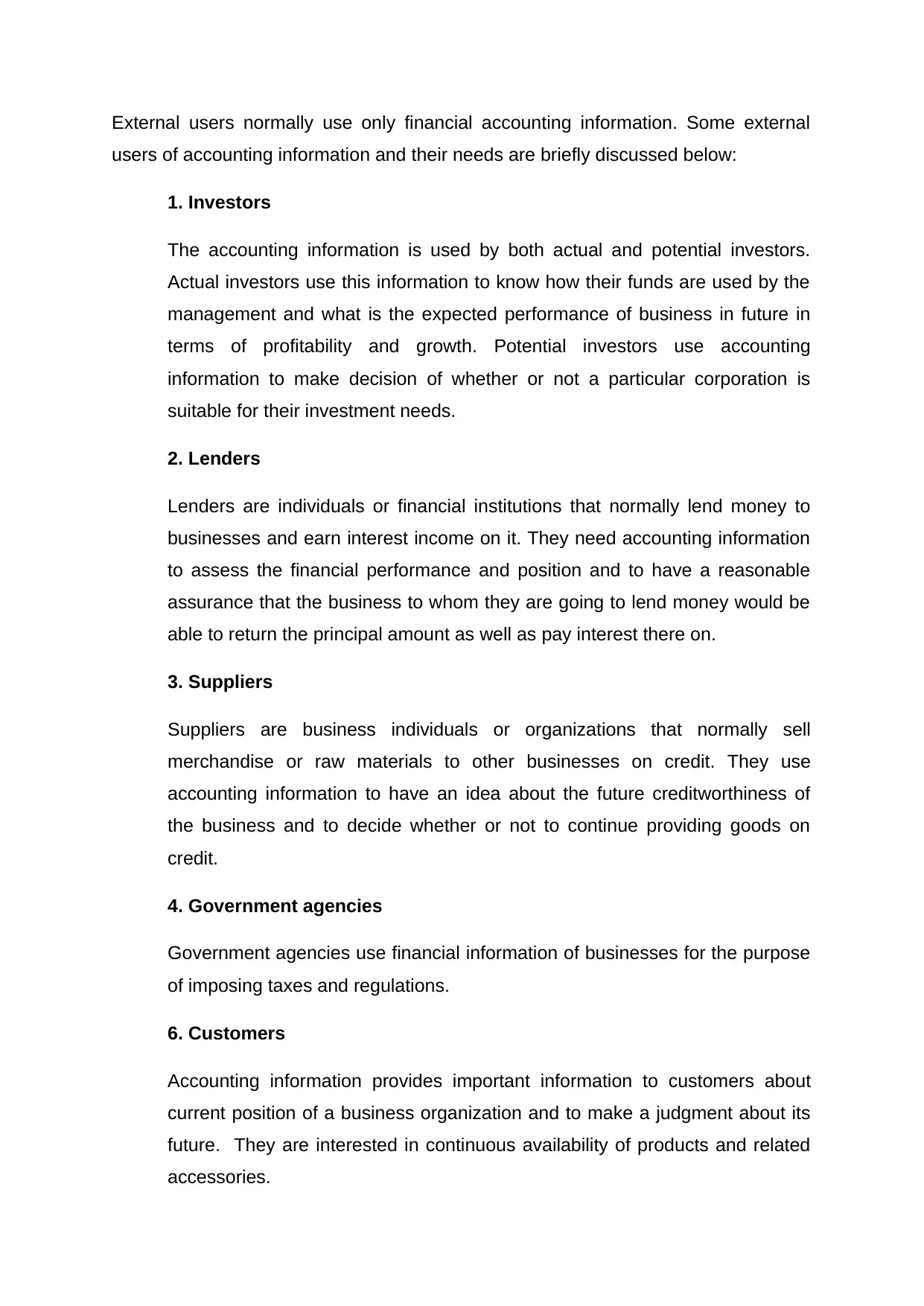
External users normally use only financial accounting information. Some external
users of accounting information and their needs are briefly discussed below:
1. Investors
The accounting information is used by both actual and potential investors.
Actual investors use this information to know how their funds are used by the
management and what is the expected performance of business in future in
terms of profitability and growth. Potential investors use accounting
information to make decision of whether or not a particular corporation is
suitable for their investment needs.
2. Lenders
Lenders are individuals or financial institutions that normally lend money to
businesses and earn interest income on it. They need accounting information
to assess the financial performance and position and to have a reasonable
assurance that the business to whom they are going to lend money would be
able to return the principal amount as well as pay interest there on.
3. Suppliers
Suppliers are business individuals or organizations that normally sell
merchandise or raw materials to other businesses on credit. They use
accounting information to have an idea about the future creditworthiness of
the business and to decide whether or not to continue providing goods on
credit.
4. Government agencies
Government agencies use financial information of businesses for the purpose
of imposing taxes and regulations.
6. Customers
Accounting information provides important information to customers about
current position of a business organization and to make a judgment about its
future. They are interested in continuous availability of products and related
accessories.
users of accounting information and their needs are briefly discussed below:
1. Investors
The accounting information is used by both actual and potential investors.
Actual investors use this information to know how their funds are used by the
management and what is the expected performance of business in future in
terms of profitability and growth. Potential investors use accounting
information to make decision of whether or not a particular corporation is
suitable for their investment needs.
2. Lenders
Lenders are individuals or financial institutions that normally lend money to
businesses and earn interest income on it. They need accounting information
to assess the financial performance and position and to have a reasonable
assurance that the business to whom they are going to lend money would be
able to return the principal amount as well as pay interest there on.
3. Suppliers
Suppliers are business individuals or organizations that normally sell
merchandise or raw materials to other businesses on credit. They use
accounting information to have an idea about the future creditworthiness of
the business and to decide whether or not to continue providing goods on
credit.
4. Government agencies
Government agencies use financial information of businesses for the purpose
of imposing taxes and regulations.
6. Customers
Accounting information provides important information to customers about
current position of a business organization and to make a judgment about its
future. They are interested in continuous availability of products and related
accessories.
⊘ This is a preview!⊘
Do you want full access?
Subscribe today to unlock all pages.

Trusted by 1+ million students worldwide
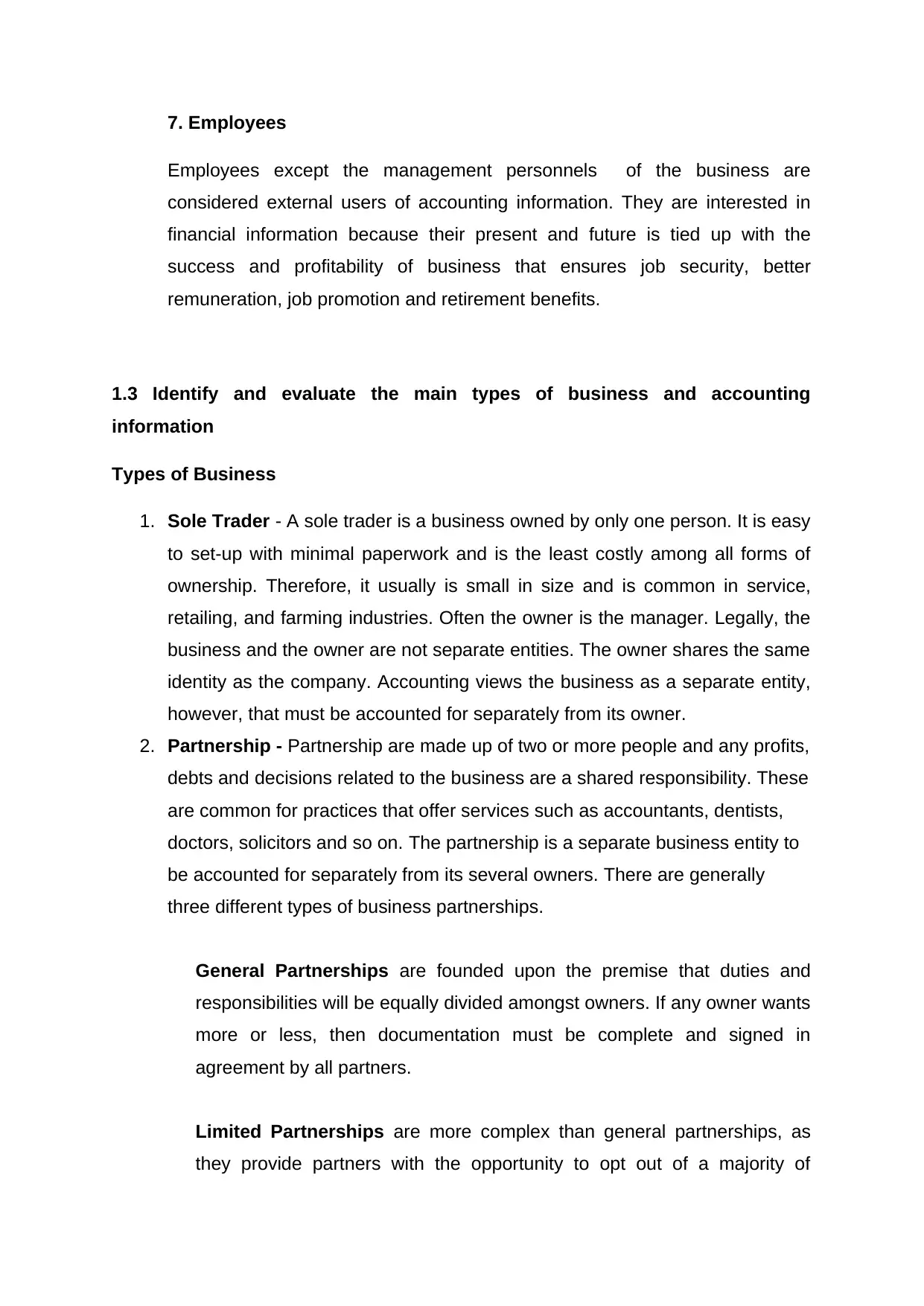
7. Employees
Employees except the management personnels of the business are
considered external users of accounting information. They are interested in
financial information because their present and future is tied up with the
success and profitability of business that ensures job security, better
remuneration, job promotion and retirement benefits.
1.3 Identify and evaluate the main types of business and accounting
information
Types of Business
1. Sole Trader - A sole trader is a business owned by only one person. It is easy
to set-up with minimal paperwork and is the least costly among all forms of
ownership. Therefore, it usually is small in size and is common in service,
retailing, and farming industries. Often the owner is the manager. Legally, the
business and the owner are not separate entities. The owner shares the same
identity as the company. Accounting views the business as a separate entity,
however, that must be accounted for separately from its owner.
2. Partnership - Partnership are made up of two or more people and any profits,
debts and decisions related to the business are a shared responsibility. These
are common for practices that offer services such as accountants, dentists,
doctors, solicitors and so on. The partnership is a separate business entity to
be accounted for separately from its several owners. There are generally
three different types of business partnerships.
General Partnerships are founded upon the premise that duties and
responsibilities will be equally divided amongst owners. If any owner wants
more or less, then documentation must be complete and signed in
agreement by all partners.
Limited Partnerships are more complex than general partnerships, as
they provide partners with the opportunity to opt out of a majority of
Employees except the management personnels of the business are
considered external users of accounting information. They are interested in
financial information because their present and future is tied up with the
success and profitability of business that ensures job security, better
remuneration, job promotion and retirement benefits.
1.3 Identify and evaluate the main types of business and accounting
information
Types of Business
1. Sole Trader - A sole trader is a business owned by only one person. It is easy
to set-up with minimal paperwork and is the least costly among all forms of
ownership. Therefore, it usually is small in size and is common in service,
retailing, and farming industries. Often the owner is the manager. Legally, the
business and the owner are not separate entities. The owner shares the same
identity as the company. Accounting views the business as a separate entity,
however, that must be accounted for separately from its owner.
2. Partnership - Partnership are made up of two or more people and any profits,
debts and decisions related to the business are a shared responsibility. These
are common for practices that offer services such as accountants, dentists,
doctors, solicitors and so on. The partnership is a separate business entity to
be accounted for separately from its several owners. There are generally
three different types of business partnerships.
General Partnerships are founded upon the premise that duties and
responsibilities will be equally divided amongst owners. If any owner wants
more or less, then documentation must be complete and signed in
agreement by all partners.
Limited Partnerships are more complex than general partnerships, as
they provide partners with the opportunity to opt out of a majority of
Paraphrase This Document
Need a fresh take? Get an instant paraphrase of this document with our AI Paraphraser
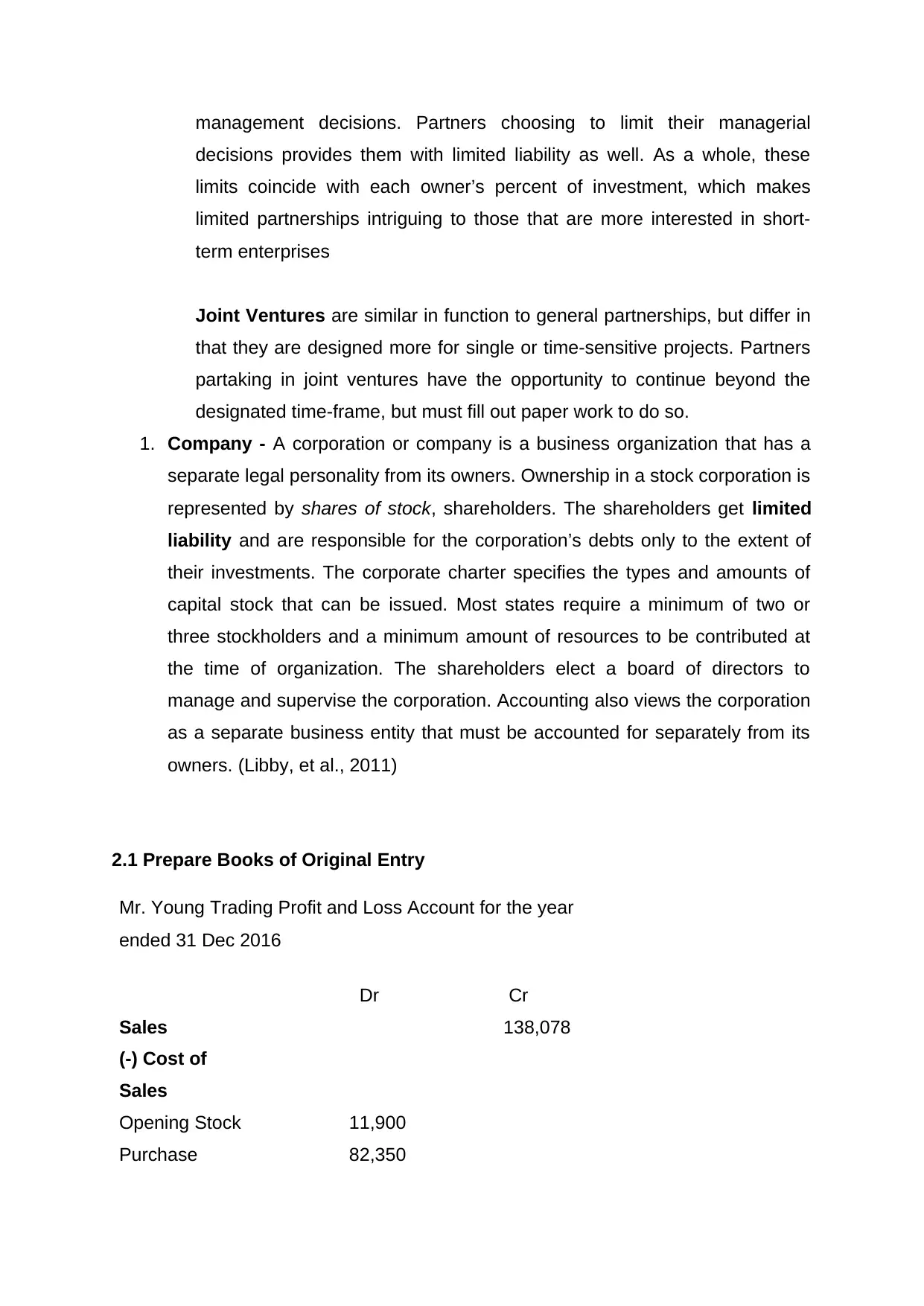
management decisions. Partners choosing to limit their managerial
decisions provides them with limited liability as well. As a whole, these
limits coincide with each owner’s percent of investment, which makes
limited partnerships intriguing to those that are more interested in short-
term enterprises
Joint Ventures are similar in function to general partnerships, but differ in
that they are designed more for single or time-sensitive projects. Partners
partaking in joint ventures have the opportunity to continue beyond the
designated time-frame, but must fill out paper work to do so.
1. Company - A corporation or company is a business organization that has a
separate legal personality from its owners. Ownership in a stock corporation is
represented by shares of stock, shareholders. The shareholders get limited
liability and are responsible for the corporation’s debts only to the extent of
their investments. The corporate charter specifies the types and amounts of
capital stock that can be issued. Most states require a minimum of two or
three stockholders and a minimum amount of resources to be contributed at
the time of organization. The shareholders elect a board of directors to
manage and supervise the corporation. Accounting also views the corporation
as a separate business entity that must be accounted for separately from its
owners. (Libby, et al., 2011)
2.1 Prepare Books of Original Entry
Mr. Young Trading Profit and Loss Account for the year
ended 31 Dec 2016
Dr Cr
Sales 138,078
(-) Cost of
Sales
Opening Stock 11,900
Purchase 82,350
decisions provides them with limited liability as well. As a whole, these
limits coincide with each owner’s percent of investment, which makes
limited partnerships intriguing to those that are more interested in short-
term enterprises
Joint Ventures are similar in function to general partnerships, but differ in
that they are designed more for single or time-sensitive projects. Partners
partaking in joint ventures have the opportunity to continue beyond the
designated time-frame, but must fill out paper work to do so.
1. Company - A corporation or company is a business organization that has a
separate legal personality from its owners. Ownership in a stock corporation is
represented by shares of stock, shareholders. The shareholders get limited
liability and are responsible for the corporation’s debts only to the extent of
their investments. The corporate charter specifies the types and amounts of
capital stock that can be issued. Most states require a minimum of two or
three stockholders and a minimum amount of resources to be contributed at
the time of organization. The shareholders elect a board of directors to
manage and supervise the corporation. Accounting also views the corporation
as a separate business entity that must be accounted for separately from its
owners. (Libby, et al., 2011)
2.1 Prepare Books of Original Entry
Mr. Young Trading Profit and Loss Account for the year
ended 31 Dec 2016
Dr Cr
Sales 138,078
(-) Cost of
Sales
Opening Stock 11,900
Purchase 82,350
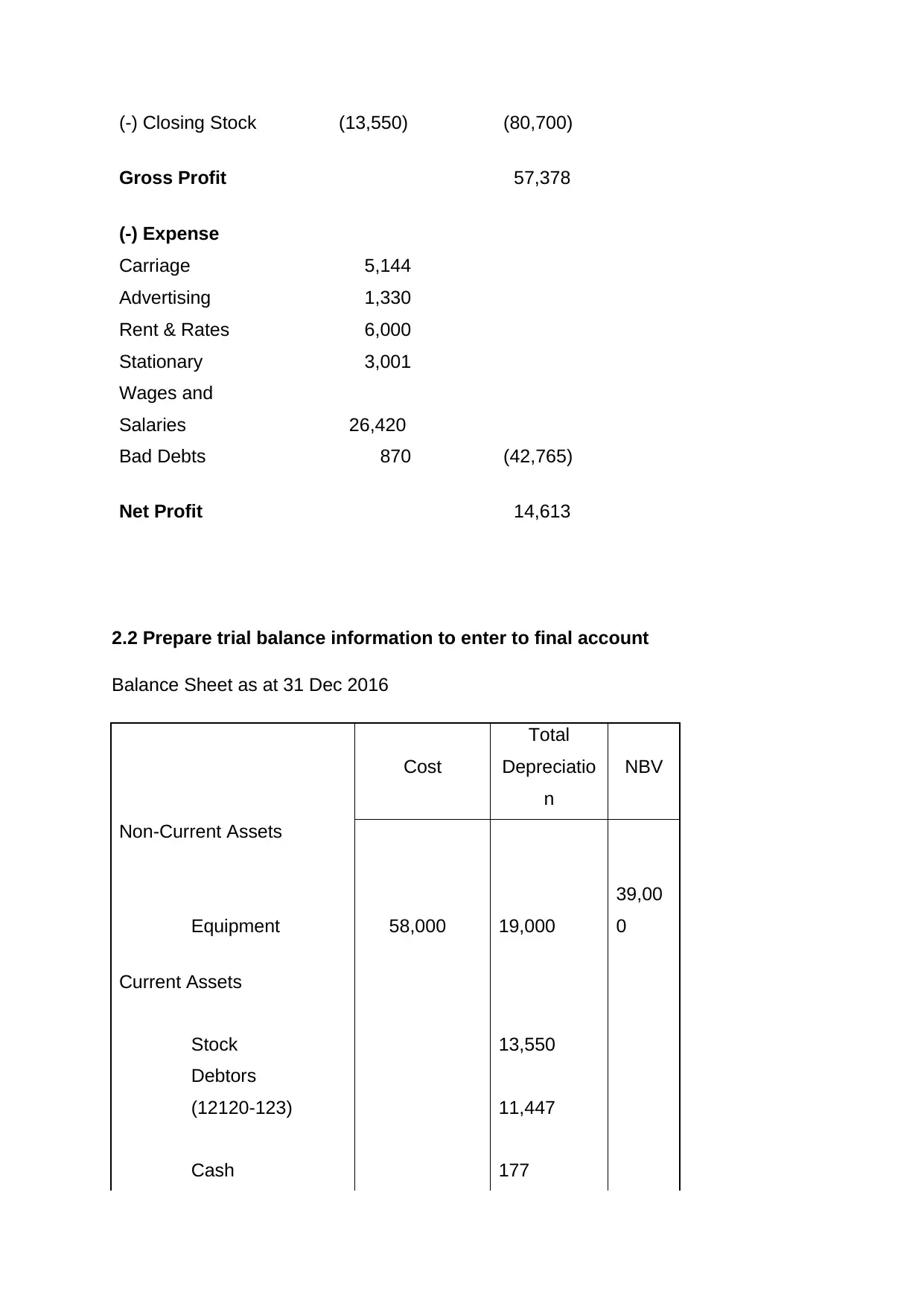
(-) Closing Stock (13,550) (80,700)
Gross Profit 57,378
(-) Expense
Carriage 5,144
Advertising 1,330
Rent & Rates 6,000
Stationary 3,001
Wages and
Salaries 26,420
Bad Debts 870 (42,765)
Net Profit 14,613
2.2 Prepare trial balance information to enter to final account
Balance Sheet as at 31 Dec 2016
Cost
Total
Depreciatio
n
NBV
Non-Current Assets
Equipment 58,000 19,000
39,00
0
Current Assets
Stock 13,550
Debtors
(12120-123) 11,447
Cash 177
Gross Profit 57,378
(-) Expense
Carriage 5,144
Advertising 1,330
Rent & Rates 6,000
Stationary 3,001
Wages and
Salaries 26,420
Bad Debts 870 (42,765)
Net Profit 14,613
2.2 Prepare trial balance information to enter to final account
Balance Sheet as at 31 Dec 2016
Cost
Total
Depreciatio
n
NBV
Non-Current Assets
Equipment 58,000 19,000
39,00
0
Current Assets
Stock 13,550
Debtors
(12120-123) 11,447
Cash 177
⊘ This is a preview!⊘
Do you want full access?
Subscribe today to unlock all pages.

Trusted by 1+ million students worldwide
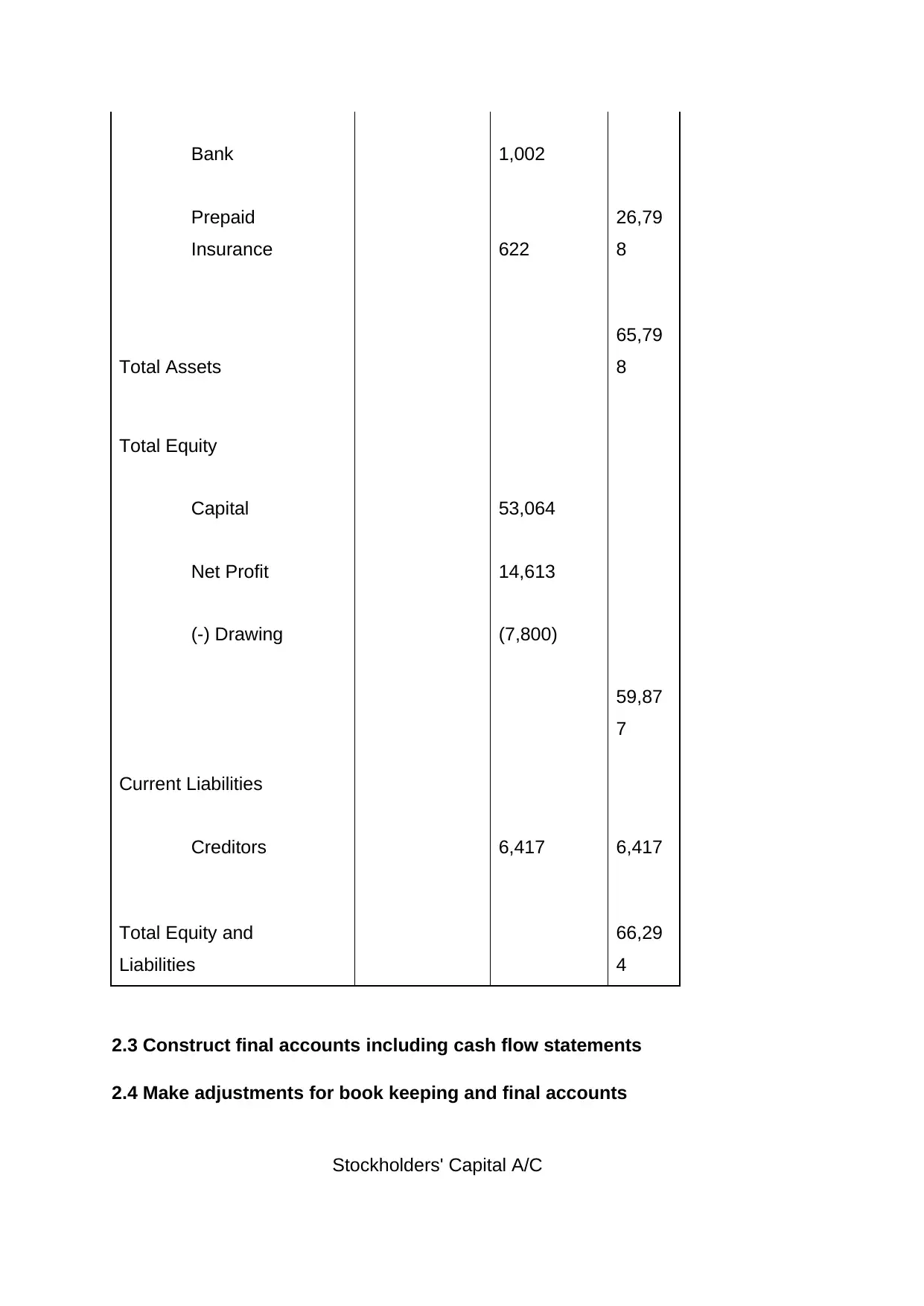
Bank 1,002
Prepaid
Insurance 622
26,79
8
Total Assets
65,79
8
Total Equity
Capital 53,064
Net Profit 14,613
(-) Drawing (7,800)
59,87
7
Current Liabilities
Creditors 6,417 6,417
Total Equity and
Liabilities
66,29
4
2.3 Construct final accounts including cash flow statements
2.4 Make adjustments for book keeping and final accounts
Stockholders' Capital A/C
Prepaid
Insurance 622
26,79
8
Total Assets
65,79
8
Total Equity
Capital 53,064
Net Profit 14,613
(-) Drawing (7,800)
59,87
7
Current Liabilities
Creditors 6,417 6,417
Total Equity and
Liabilities
66,29
4
2.3 Construct final accounts including cash flow statements
2.4 Make adjustments for book keeping and final accounts
Stockholders' Capital A/C
Paraphrase This Document
Need a fresh take? Get an instant paraphrase of this document with our AI Paraphraser
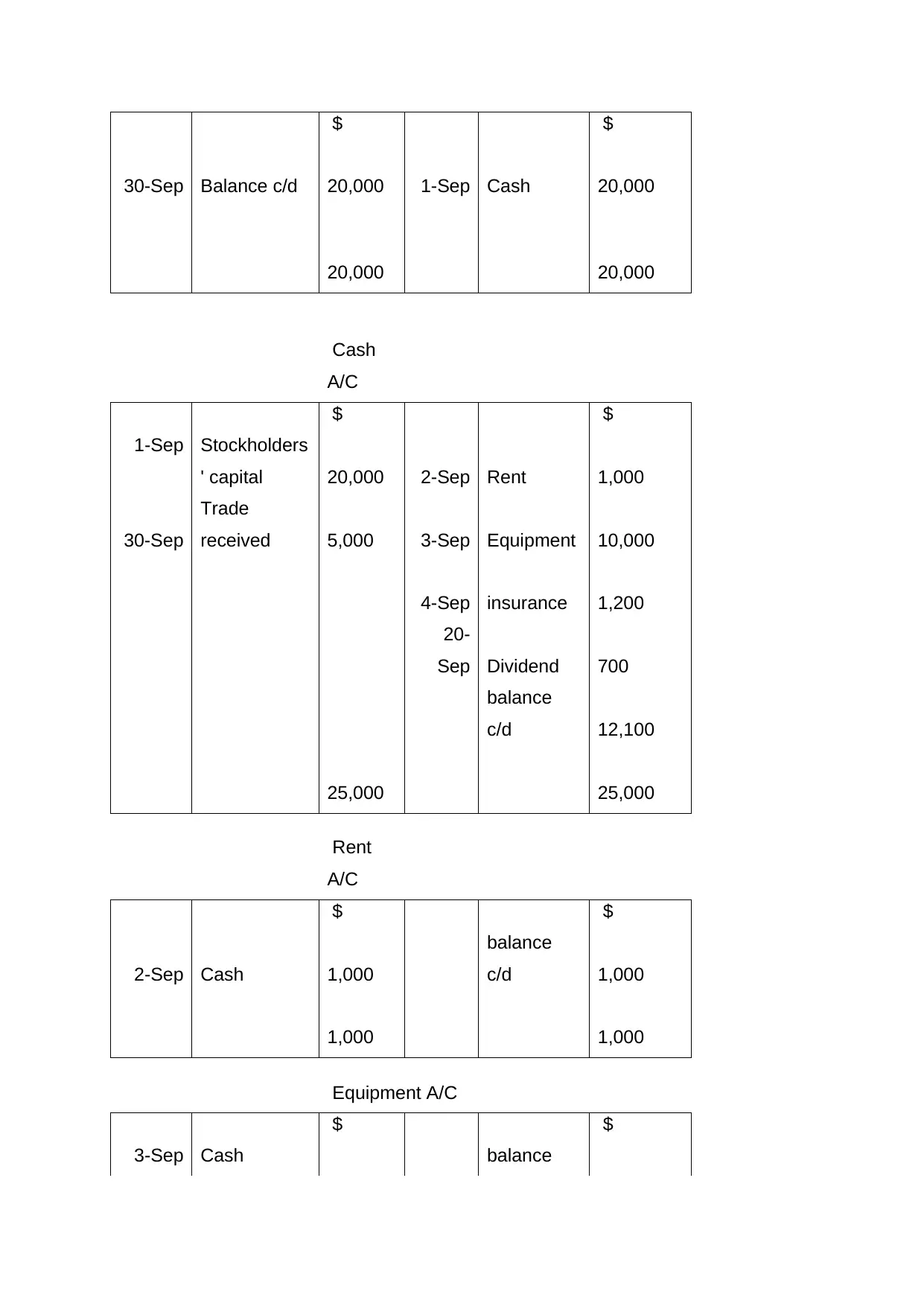
$ $
30-Sep Balance c/d 20,000 1-Sep Cash 20,000
20,000 20,000
Cash
A/C
$ $
1-Sep Stockholders
' capital 20,000 2-Sep Rent 1,000
30-Sep
Trade
received 5,000 3-Sep Equipment 10,000
4-Sep insurance 1,200
20-
Sep Dividend 700
balance
c/d 12,100
25,000 25,000
Rent
A/C
$ $
2-Sep Cash 1,000
balance
c/d 1,000
1,000 1,000
Equipment A/C
$ $
3-Sep Cash balance
30-Sep Balance c/d 20,000 1-Sep Cash 20,000
20,000 20,000
Cash
A/C
$ $
1-Sep Stockholders
' capital 20,000 2-Sep Rent 1,000
30-Sep
Trade
received 5,000 3-Sep Equipment 10,000
4-Sep insurance 1,200
20-
Sep Dividend 700
balance
c/d 12,100
25,000 25,000
Rent
A/C
$ $
2-Sep Cash 1,000
balance
c/d 1,000
1,000 1,000
Equipment A/C
$ $
3-Sep Cash balance
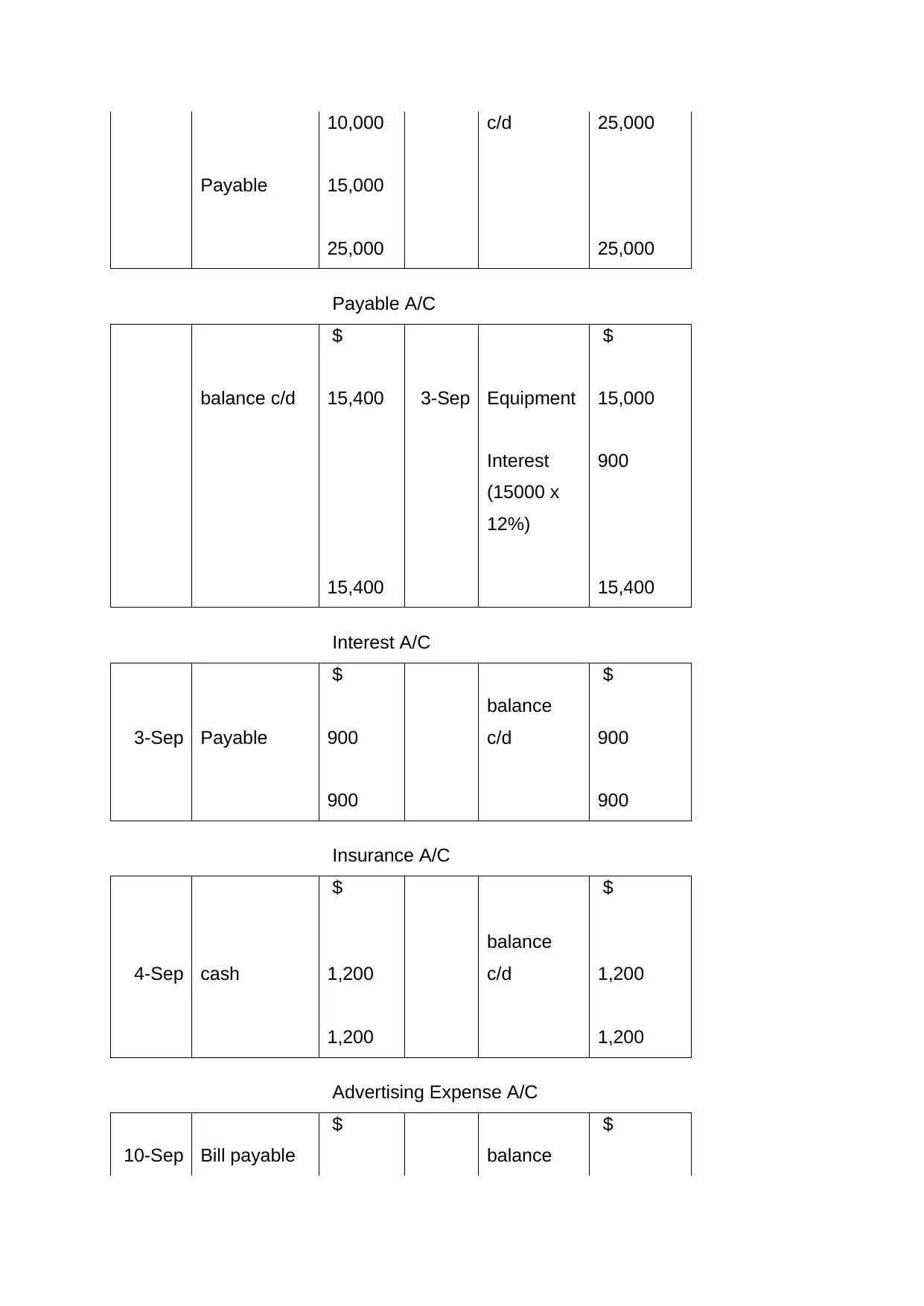
10,000 c/d 25,000
Payable 15,000
25,000 25,000
Payable A/C
$ $
balance c/d 15,400 3-Sep Equipment 15,000
Interest 900
(15000 x
12%)
15,400 15,400
Interest A/C
$ $
3-Sep Payable 900
balance
c/d 900
900 900
Insurance A/C
$ $
4-Sep cash 1,200
balance
c/d 1,200
1,200 1,200
Advertising Expense A/C
$ $
10-Sep Bill payable balance
Payable 15,000
25,000 25,000
Payable A/C
$ $
balance c/d 15,400 3-Sep Equipment 15,000
Interest 900
(15000 x
12%)
15,400 15,400
Interest A/C
$ $
3-Sep Payable 900
balance
c/d 900
900 900
Insurance A/C
$ $
4-Sep cash 1,200
balance
c/d 1,200
1,200 1,200
Advertising Expense A/C
$ $
10-Sep Bill payable balance
⊘ This is a preview!⊘
Do you want full access?
Subscribe today to unlock all pages.

Trusted by 1+ million students worldwide
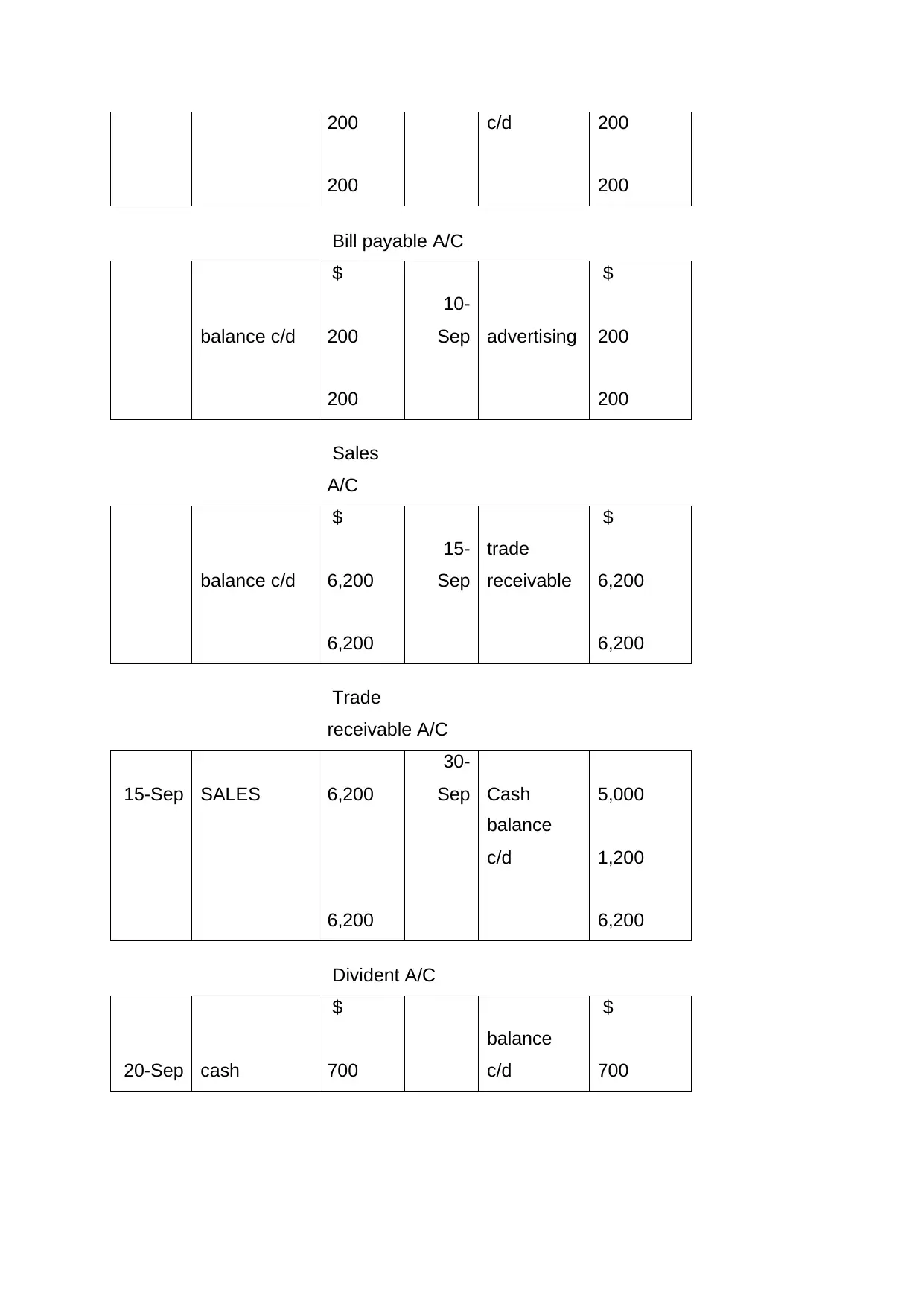
200 c/d 200
200 200
Bill payable A/C
$ $
balance c/d 200
10-
Sep advertising 200
200 200
Sales
A/C
$ $
balance c/d 6,200
15-
Sep
trade
receivable 6,200
6,200 6,200
Trade
receivable A/C
15-Sep SALES 6,200
30-
Sep Cash 5,000
balance
c/d 1,200
6,200 6,200
Divident A/C
$ $
20-Sep cash 700
balance
c/d 700
200 200
Bill payable A/C
$ $
balance c/d 200
10-
Sep advertising 200
200 200
Sales
A/C
$ $
balance c/d 6,200
15-
Sep
trade
receivable 6,200
6,200 6,200
Trade
receivable A/C
15-Sep SALES 6,200
30-
Sep Cash 5,000
balance
c/d 1,200
6,200 6,200
Divident A/C
$ $
20-Sep cash 700
balance
c/d 700
Paraphrase This Document
Need a fresh take? Get an instant paraphrase of this document with our AI Paraphraser
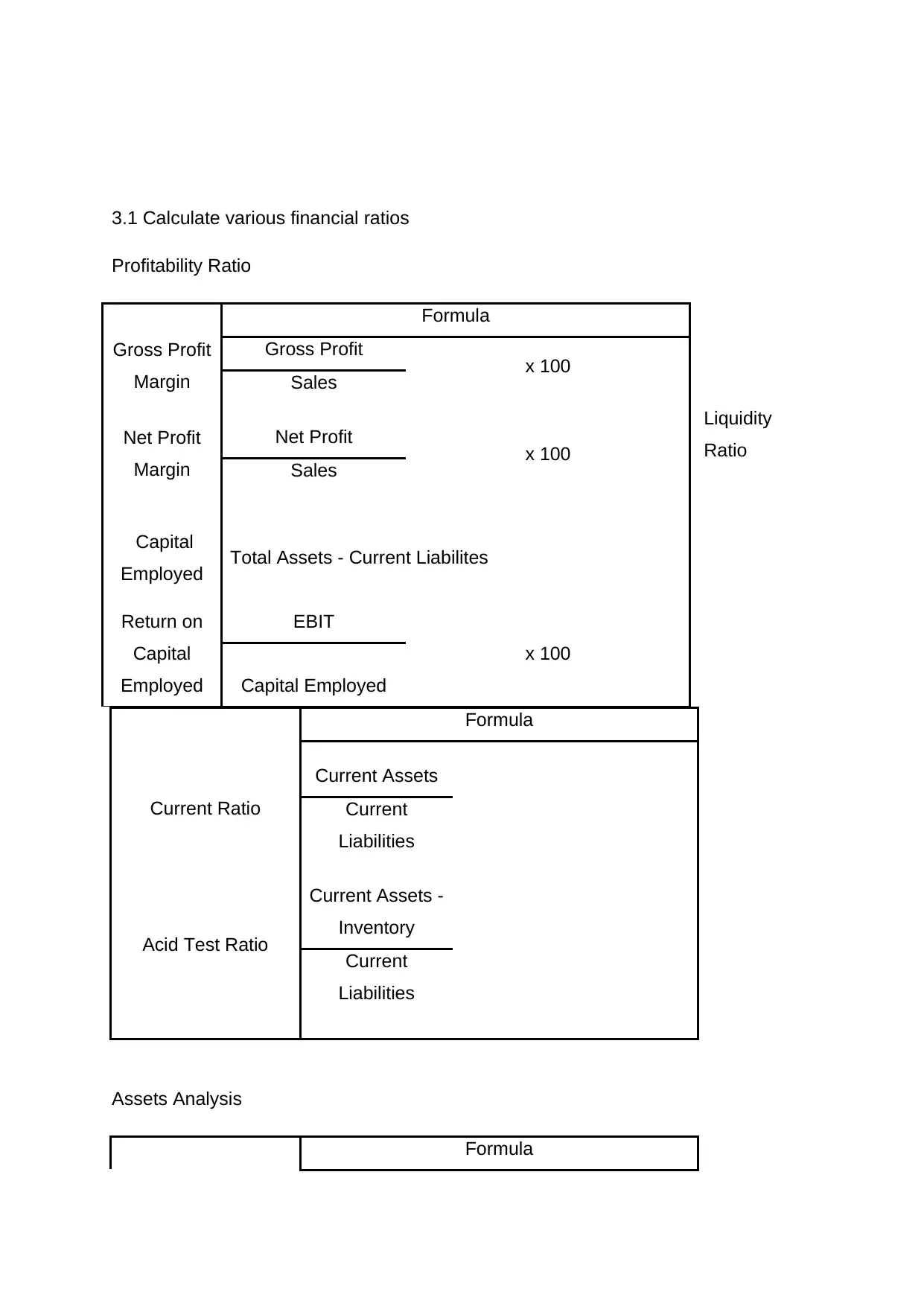
3.1 Calculate various financial ratios
Profitability Ratio
Liquidity
Ratio
Formula
Current Ratio
Current Assets
Current
Liabilities
Acid Test Ratio
Current Assets -
Inventory
Current
Liabilities
Assets Analysis
Formula
Formula
Gross Profit
Margin
Gross Profit x 100
Sales
Net Profit
Margin
Net Profit x 100
Sales
Capital
Employed Total Assets - Current Liabilites
Return on
Capital
Employed
EBIT
x 100
Capital Employed
Profitability Ratio
Liquidity
Ratio
Formula
Current Ratio
Current Assets
Current
Liabilities
Acid Test Ratio
Current Assets -
Inventory
Current
Liabilities
Assets Analysis
Formula
Formula
Gross Profit
Margin
Gross Profit x 100
Sales
Net Profit
Margin
Net Profit x 100
Sales
Capital
Employed Total Assets - Current Liabilites
Return on
Capital
Employed
EBIT
x 100
Capital Employed
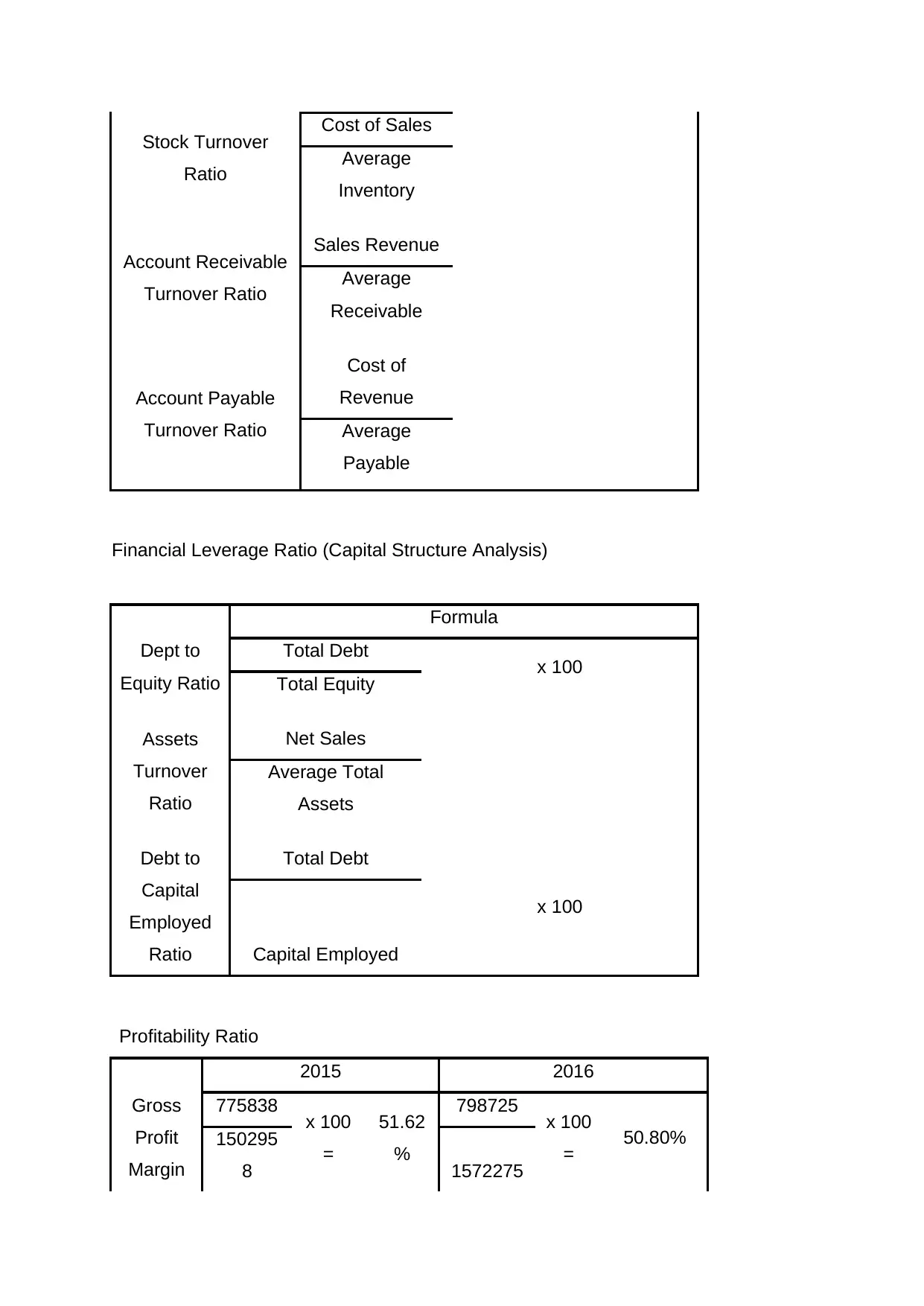
Stock Turnover
Ratio
Cost of Sales
Average
Inventory
Account Receivable
Turnover Ratio
Sales Revenue
Average
Receivable
Account Payable
Turnover Ratio
Cost of
Revenue
Average
Payable
Financial Leverage Ratio (Capital Structure Analysis)
Formula
Dept to
Equity Ratio
Total Debt x 100
Total Equity
Assets
Turnover
Ratio
Net Sales
Average Total
Assets
Debt to
Capital
Employed
Ratio
Total Debt
x 100
Capital Employed
Profitability Ratio
2015 2016
Gross
Profit
Margin
775838 x 100
=
51.62
%
798725 x 100
= 50.80%150295
8 1572275
Ratio
Cost of Sales
Average
Inventory
Account Receivable
Turnover Ratio
Sales Revenue
Average
Receivable
Account Payable
Turnover Ratio
Cost of
Revenue
Average
Payable
Financial Leverage Ratio (Capital Structure Analysis)
Formula
Dept to
Equity Ratio
Total Debt x 100
Total Equity
Assets
Turnover
Ratio
Net Sales
Average Total
Assets
Debt to
Capital
Employed
Ratio
Total Debt
x 100
Capital Employed
Profitability Ratio
2015 2016
Gross
Profit
Margin
775838 x 100
=
51.62
%
798725 x 100
= 50.80%150295
8 1572275
⊘ This is a preview!⊘
Do you want full access?
Subscribe today to unlock all pages.

Trusted by 1+ million students worldwide
1 out of 17
Related Documents
Your All-in-One AI-Powered Toolkit for Academic Success.
+13062052269
info@desklib.com
Available 24*7 on WhatsApp / Email
![[object Object]](/_next/static/media/star-bottom.7253800d.svg)
Unlock your academic potential
Copyright © 2020–2025 A2Z Services. All Rights Reserved. Developed and managed by ZUCOL.




